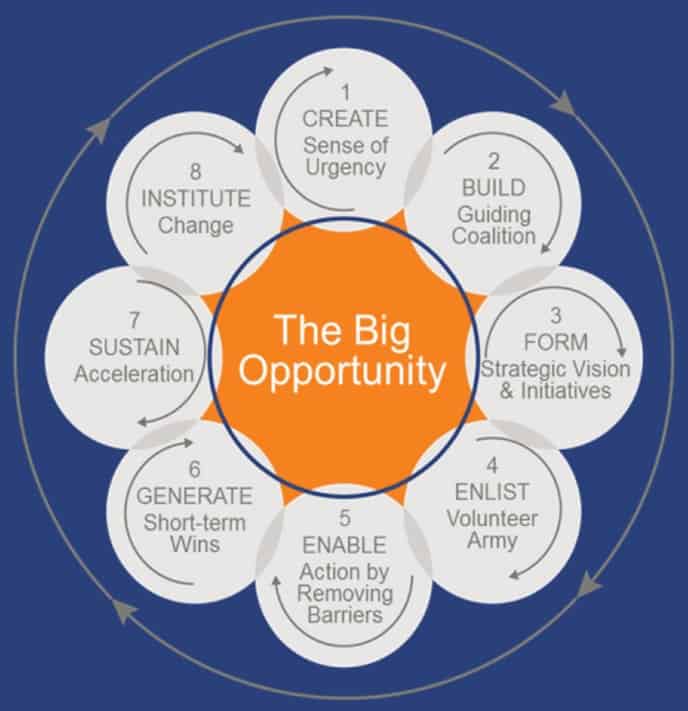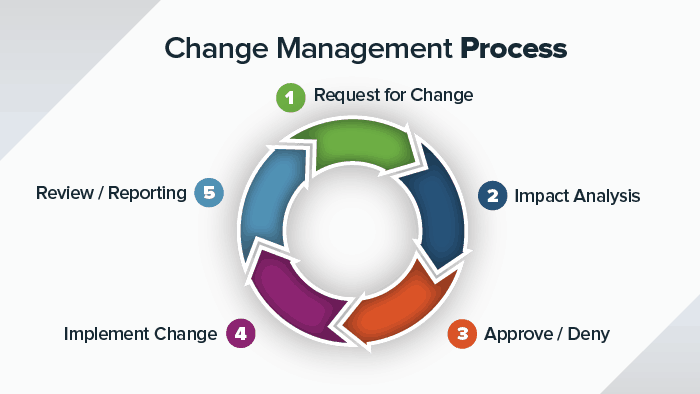History of Change Management
The philosophies behind today's change management practices are structured to anticipate the challenges of organizational change. This framework emerged in the 1940s and was adopted by businesses later in the century, and continued to evolve over time.
The concept of change management dates back to the early to mid-1900s. Kurt Lewin’s 3-step model for change was developed in the 1940s; Everett Rogers’ book Diffusion of Innovations was published in 1962, and Bridges’ Transition Model was developed in 1979. However, it wasn’t until the 1990s that change management became well known in the business environment, and formal organizational processes became available in the 2000s.
There are concrete reasons for accelerated growth in the change management industry. Products, technology, or ideas that used to take years to design, develop, test, and deploy are now being squeezed down to months or even weeks. The evolving consumer expectations for better, faster, and cheaper products also drive the need to reorganize the work culture to meet demand. Books touting these concepts run from the obvious, such as Change the Culture, Change the Game by Roger Connors and Tom Smith, to Alan Deutschman's dire call to action in Change or Die, Linda Ackerman Anderson’s Beyond Change Management, and Daryl Conner’s Managing at the Speed of Change. In addition, models and certifications from The Association of Change Management Professionals have come to life in support of this growing industry.
See how Smartsheet can help you be more effective
Watch the demo to see how you can more effectively manage your team, projects, and processes with real-time work management in Smartsheet.
Understanding Change Management Terminology
As a discipline, change management has evolved to include change management models, processes, and plans that help reduce the negative impact of change on organizations. We’ve broken down the differences between these elements below:
- Change Management Models have been developed based on research and experience on how to best manage change within an organization or in your personal life. Most Change Management Models provide a supporting process that can apply to your organization or personal growth.
- Change Management Processes include a sequence of steps or activities that move a change from inception to delivery.
- Change Management Plans are developed to support a project to deliver a change. It is typically created during the planning stage of a Change Management Process.
Here is a great resource for an overview of effective change models, methodologies, and frameworks. You’ll find theories such as the McKinsey’s change management framework, John Kotter’s change management model, the Prosci ADKAR process, and the Deming Cycle.
8 Essential Steps for an Effective Change Management Process
Change management processes should include the following steps: First, identify opportunities for improvement and secure approval from stakeholders. Then, make a plan and evaluate your processes. Communicate the changes, monitor progress, and continue to assess any risks.
All organizations constantly experience change, whether caused by new technology implementations, process updates, compliance initiatives, reorganization, or customer service improvements. But, this isn’t necessarily negative — in fact, change is often necessary for growth and profitability. Our 2025 project and portfolio management priorities report, which surveyed more than 1,450 project and portfolio management (PPM) professionals, found that 99 percent of PPM professionals believed their organization would benefit from better technology and tools that help them adapt to change. A consistent change management process will aid in minimizing the negative impact of change on your organization and staff.
We’ve outlined the eight essential steps to an effective change management process below.
1. Identify What Will Be Improved
Since most change occurs to improve a process, a product, or an outcome, it is critical to identify the focus and to clarify goals. This also involves identifying the resources and individuals that will facilitate the process and lead the endeavor. Most change systems acknowledge that knowing what to improve creates a solid foundation for clarity, ease, and successful implementation.
2. Present a Solid Business Case to Stakeholders
There are several layers of stakeholders that include upper management who both direct and finance the endeavor, champions of the process, and those who are directly charged with instituting the new normal. All have different expectations and experiences and there must be a high level of "buy-in" from across the spectrum. The process of onboarding the different constituents varies with each change framework, but all provide plans that call for the time, patience, and communication.
3 .Plan for the Change
This is the "roadmap" that identifies the beginning, the route to be taken, and the destination. You will also integrate resources to be leveraged, the scope or objective, and costs into the plan. A critical element of planning is providing a multi-step process rather than sudden, unplanned "sweeping" changes. This involves outlining the project with clear steps with measurable targets, incentives, measurements, and analysis. For example, a well-planed and controlled change management process for IT services will dramatically reduce the impact of IT infrastructure changes on the business. There is also a universal caution to practice patience throughout this process and avoid shortcuts.
4. Provide Resources and Use Data for Evaluation
As part of the planning process, resource identification and funding are crucial elements. These can include infrastructure, equipment, and software systems. Also consider the tools needed for re-education, retraining, and rethinking priorities and practices. Many models identify data gathering and analysis as an underutilized element. The clarity of clear reporting on progress allows for better communication, proper and timely distribution of incentives, and measuring successes and milestones.
5. Communication
This is the "golden thread" that runs through the entire practice of change management. Identifying, planning, onboarding, and executing a good change management plan is dependent on good communication. Unfortunately, 45 percent of PPM professionals surveyed cited ‘lack of effective communication and collaboration’ as a key barrier to adapting to change. There are psychological and sociological realities inherent in group cultures. Those already involved have established skill sets, knowledge, and experiences. But they also have pecking orders, territory, and corporate customs that need to be addressed. This is why a tailored approach is required when securing buy-in from different levels of the organization (for example, the survey also found that executives are twice as likely as director-level staff to report experiencing a ‘significant increase’ in change at work). Providing clear and open lines of communication throughout the process is a critical element in all change modalities. The methods advocate transparency and two-way communication structures that provide avenues to vent frustrations, applaud what is working, and seamlessly change what doesn't work.
6. Monitor and Manage Resistance, Dependencies, and Budgeting Risks
Resistance is a very normal part of change management, but it can threaten the success of a project. Most resistance occurs due to a fear of the unknown. It also occurs because there is a fair amount of risk associated with change – the risk of impacting dependencies, return on investment risks, and risks associated with allocating budget to something new. Anticipating and preparing for resistance by arming leadership with tools to manage it will aid in a smooth change lifecycle.
7. Celebrate Success
Recognizing milestone achievements is an essential part of any project. When managing a change through its lifecycle, it’s important to recognize the success of teams and individuals involved. This will help in the adoption of both your change management process as well as adoption of the change itself.
8. Review, Revise and Continuously Improve
As much as change is difficult and even painful, it is also an ongoing process. Even change management strategies are commonly adjusted throughout a project. Like communication, this should be woven through all steps to identify and remove roadblocks. And, like the need for resources and data, this process is only as good as the commitment to measurement and analysis.
Common Challenges of Change Management
Change management, like any other business process, involves some unique challenges. From the evolving approaches to the need for continual adjustment and improvement, change management is a sometimes difficult — but always worthwhile — task.
Due to ever-changing consumer expectations and the competition in the global economy, the science of organizational change is itself constantly changing and evolving. The human element of change management may be one of the most difficult to navigate because people do not inherently like change or adjust to it well.
Most change methods agree that change is difficult and cumbersome. Therefore, it’s critical to involve people early on, implement processes, and continuously adjust for improvement. This includes thorough planning, securing buy-in and resources, developing strong communication norms, and continuously evaluating your processes.
Supporting Tools and Components for Implementing Change Management Processes
Effective change management processes rely on supporting activities and tools, which are often developed and managed by the change management team or other stakeholders. We’ve included examples of tools for implementing change management below:
- Product or Business Roadmaps
- Readiness Assessments
- Training Tutorials and Education Sessions
- Stakeholder Feedback Forums
- Post Mortem Review
- Measurements and Analytics
- Resistance Management
- Continuous Improvement Plan
- Business Case
Today, there are numerous proven methodologies. Some models focus on changing the individual as a method of cultural change and some have structures and frameworks to move an entire organization towards focused change and improvement. There is no one "right" solution, but with research, exploration, and resource planning, a change management strategy is possible regardless of organization size or need. If the explosive growth in the change management industry is any indication, the business of change is here to stay.
Managing Change in Healthcare Organizations
The healthcare industry uses digital tools to optimize its processes and procedures. Clinical tests and trials, healthcare credentialing, team onboarding, and clinic openings are all examples of processes that benefit from a more streamlined, automated approach.
However, implementing change in a healthcare organization requires high-level visibility into updates, efficient organization of contracts and timelines, and secure documentation and storage of confidential information. As the demand for better, more standardized processes increases, the need for a collaborative, visible, and real-time tool is more apparent than ever.
Smartsheet is a work execution platform that enables healthcare companies to improve work efficiency, scale repetitive processes, and securely store and share protected health information compliant with HIPAA’s regulatory requirements. Streamline documentation, improve communication across your organization, and modify healthcare processes for the better, while also maintaining top-level data security and compliance.
Interested to learn more about how Smartsheet can help you maximize your efforts? Discover Smartsheet for Healthcare.
Why Smartsheet is the Ultimate Tool for Managing Processes
Empower your people to go above and beyond with a flexible platform designed to match the needs of your team — and adapt as those needs change.
The Smartsheet platform makes it easy to plan, capture, manage, and report on work from anywhere, helping your team be more effective and get more done. Report on key metrics and get real-time visibility into work as it happens with roll-up reports, dashboards, and automated workflows built to keep your team connected and informed.
When teams have clarity into the work getting done, there’s no telling how much more they can accomplish in the same amount of time. Try Smartsheet for free, today.


